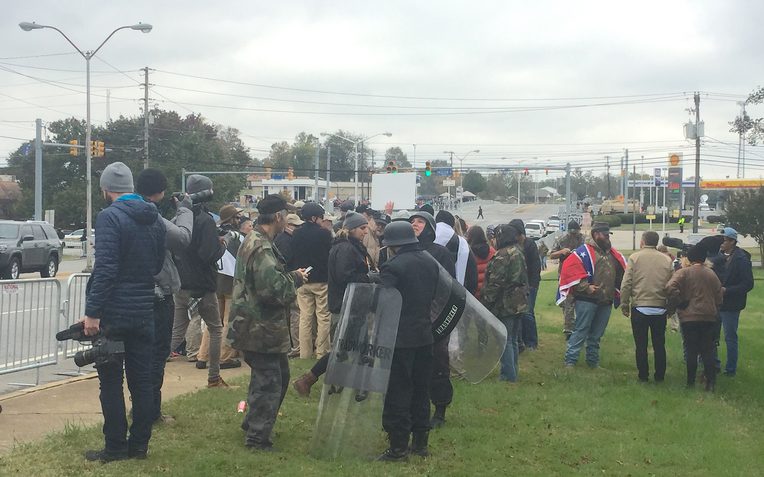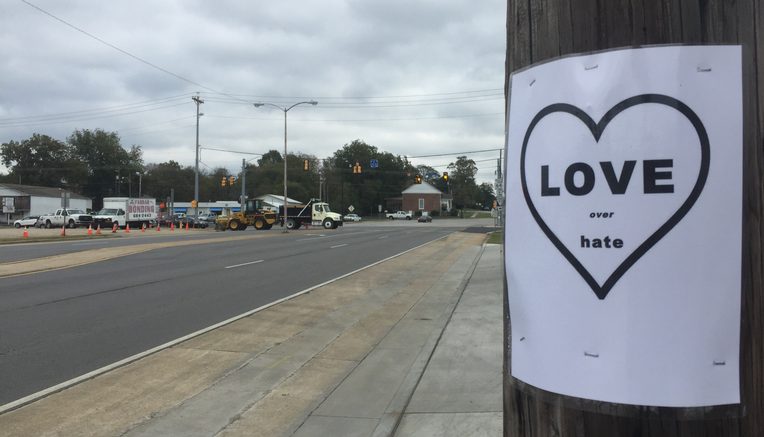Shelbyville, 2017
From the Series: American Fascism
From the Series: American Fascism
“How are you feeling?” I asked the Nepali woman behind the counter of a gas station. She replied with one word and a tight smile. “Scared.”
Scheduled to take place in Shelbyville, Tennessee, that Saturday morning was a “White Lives Matter” political rally. Businesses downtown were shuttered. Police sedans had cordoned off roads heading into the town. A pervasive thrum was in the air from the helicopters circling overhead. Armored vehicles were planted on the streets around the town square, dozens of officers in riot gear massing on the roofs of low buildings.
The October 2017 rally was expected to be the largest such event after the “Unite the Right” rally in Charlottesville, where clashes between demonstrators and counter-protesters had left dozens injured and one young woman dead. The Shelbyville rally was organized by a Southern separatist group called the League of the South, working together with a larger umbrella of white nationalist groups that called themselves the Nationalist Front.
Long metal barricades divided the white nationalists from the counter-protestors who were also gathering that morning, held to another area across the wide expanse of Lane Parkway. “Which side are you on?” an officer asked as I approached the rally site. I followed a handful of journalists into the security clearance area for the white nationalists. I was hoping to talk with some of them; I wound up being penned in with them for much of the day.
As it happened, there were a few others on this side who, like me, weren’t white: a Japanese film crew documenting the rally and an African American woman from Shelbyville who was walking around quietly, making a point through the fact of her physical presence. She warned me to be careful. “You don’t have anyone to watch your back.”
The security protocol was arduous and time-consuming. So much so that it helped break the ice with the white nationalists, forced to mill around the checkpoint, waiting to submit to a pat down and other indignities, all in the name of safety. Here was something we could complain about together, as if in a painfully slow line at an airport terminal.
I struck up a conversation with a bearded man who worked at a uniform factory in northern Alabama. He was wearing a red MAGA cap, with a American flag draped around his shoulders, as flagpoles had been banned. He admitted feeling stupid with a flag on his back.
“What would look cool is a SWAT vest and a gun,” he said, eyeing the officers nearby. “Yeah, I’d love me a SWAT vest and a gun.”
Some of these groups had come down to the checkpoint in quasi-military formation, helmeted young men in rows, marching behind plastic shields as a ruddy-faced man with a thick white beard led them in a chant: Closed borders! White nation! Now we start the deportation! Some had swastikas and the letters KKK tattooed on their arms, tucked under their sleeves.
Styled as foot soldiers, many startlingly young, these men were a deliberately provocative spectacle of fascist unity. They were also a minority among those at the rally. I was curious about the others who had come here in plain clothes. How did these ideas speak to them?

At one point, a tall man in a black Carhartt jacket started a
conversation with me. He wouldn’t divulge who he was, and nor, frankly,
would I, but it turned out that he was raised in Brooklyn, not far from
the Bronx borough where I was born. He was affable, in his late forties,
with a neatly trimmed salt-and-pepper beard. He’d gone to
Charlottesville, coming to Shelbyville just for this event.
“I have an affinity for this side,” he admitted.
“What do you think of this idea of an ethno-state?” I asked the man, bringing up the vision of a balkanized white nation floated by rally organizers. “What would you do with people like me?”
“What’s your heritage?” he asked.
“My family is from India,” I said. “I was born and raised in this country, but my parents immigrated here.”
“Aren’t you guys Aryans?” Both of us laughed.
He asked when my family had come to the United States, said he had ancestors who came during the Revolutionary War era. “Our ancestors built this country for their posterity. We feel this is our inheritance, that it’s a specific culture that made it what it is.”
As we spoke, verbal slingshots reverberated across the desolate asphalt between the white nationalists and the counter-demonstrators across the road. “Come on, let’s see that Nazi salute,” came the taunts from that side. “Why did you have to bring World War II combat helmets, Nazis? That’s sad. You must be afraid. Man, the KKK are apparently K-K-Kowards . . . ”
“It’s funny they talk about hate, about Nazis,” the man from Brooklyn observed. “These are good, decent people,” he insisted, gesturing toward the crowd of white nationalists.
“Let me tell you why I’m here,” I told him. “In the 1970s, there was a shortage of doctors in the United States. The government put out a call, and many of them came from India. My dad’s a cardiologist. Over the years, he’s probably taken care of tens of thousands of patients, saved a lot of lives. Does that give us a place here, or not?”
“Yeah, that’s a part of our history,” he replied. “We can accept that. We can absorb a certain amount of other cultures.” It was like he was speaking of a national organism, able to tolerate a certain number of foreign bodies in its midst. As noxious and dangerous as it was, this was a politics pitched to shield vulnerable bodies from existential threat, one where protection and aggression were bound tightly together.
“You gotta put your own air mask on first,” the man from Brooklyn told me. “You gotta take care of yourself before you can take care of someone else.”
Chanting among the demonstrators—White lives matter! White lives matter!—reached
a crescendo, as I spoke with an older man wearing a Confederate States
of America belt buckle. A security consultant tapped me on the shoulder,
telling me to turn around—“You don’t want your back to this.”
The young fascists were banging their shields in unison, preparing to march away from the demonstration site. One of them taunted us with a Love Over Hate flyer ripped from a telephone pole—“You lost a sign, buddies”—as they walked past. They kept going, and I followed them out unscathed.

I walked back along North Main Street, stopping into a restaurant called El Mexico. I could see, when I sat down, that my hands were trembling with the strain of having passed the day on an even keel, coils of tension finally easing into a state of normalcy. I texted home to say I was OK.
The Latino man who seated me was born in the United States, had lived in Shelbyville for fifteen years. He told me something curious, almost funny, about the people streaming into the restaurant now that the rally was over. “They go to the rally, come sit down to eat. We don’t know what side they were on.”
Indeed, having seen what I’d seen, it seemed entirely plausible that someone could spend the day rallying for a white nation, then stop in for a quick burrito. That feeling stayed with me as I walked down the road back to my hotel, trailing all the big black pickup trucks rolling out of town. Who could say what side they were on, those behind those dark tinted windows. All of it, as I walked, began to look slightly ominous.